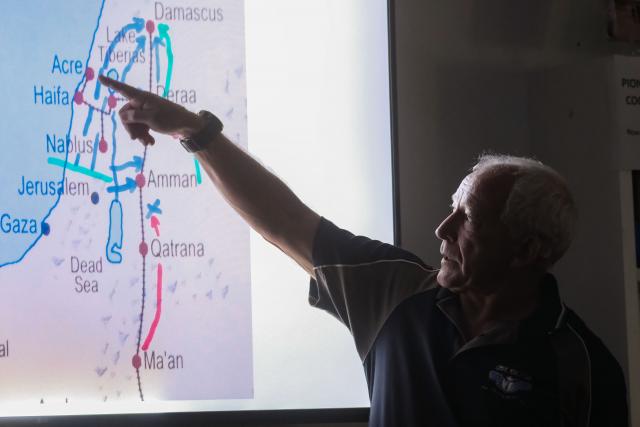How the Anzacs saved the British Empire in WWI was the topic when in the lead up to Anzac Day the Cooroy-Noosa Genealogy Group hosted guest speaker Neil Dearberg, Chief Historian for the Desert Anzacs and President of the Military Historical Society of Queensland.
It was the Anzac’s defeat of the German-Ottoman offensive in a little known battle at Romani, Turkey, in 3-5 August 1916, at the beginning of the Sinai Palestine Campaign 1916-1918 which saved a takeover of the Suez Canal, ensuring vital passage for the British forces, Neil told the audience.
“If the British lost the Suez Canal they would have lost the war,“ he said.
Most of the Australian Imperial Force (AIF) went to France in 1916, where British forces were focused, after the Gallipoli Campaign, but the mounted units remained in Egypt to continue the fight against the Ottoman Army. The Ottoman threat to the Suez Canal ended with the Allied victory at Romani after which the Australians and other units in the Egyptian Expeditionary Force (EEF) advanced into Ottoman territory. They were supported by Arabs involved in an uprising against the Ottoman colonial rule. Begun by ruler of the Hejaz province Grand Sherif Hussein and led by his four sons, Ali, Abdullah, Feisal and Zeid it became known as the Arab revolt.
Neil said Great Britain maintained its empire only with the support of its colonies in Australia, New Zealand, India, Canada and South Africa and the Suez Canal was a key transport route.
Had the allied forces not been able to go through they would have been at the mercy of the vast Atlantic Ocean and German U-boats.
During the war the British were obsessed with the western front and the battle raging in France, Neil said. They didn’t understand what was happening throughout Egypt, Turkey and the Middle East.
During WWI the British had the support of its colonies, the EEF, France, Ghurkas, West Indies and Russia.
Against them were the Ottomans (the Turks), Germany and its colonies.
In 1914 the once powerful Ottoman Empire was in decline with international debt and having lost Egypt, Libya, Balkans and Algeria in previous battles, Neil said.
In 1896 the Ottomans defaulted on their repayments on the Suez Canal and Britain took charge of it.
During WWI Britain declared the Suez Canal a protectorate preventing the Germans from sailing through it.
A combination of factors resulted in the victory of the Romani battle and paramount was the might and spirit of the Anzacs of 100 years ago and some exceptional leaders including Lieutenant General Harry Chauvel and Major general Edward Chayter.
The Anzacs were stockmen, graziers, explorers, foresters, shipbuilders, Neil said. They were great outdoors men who could ride horses, live off the land and shoot. They were used to roughing it, able to use their initiative and were accustomed to relying on each other to survive. They were egalitarian and adventurous. They were far removed from the pompous, class conscious British army of the time, he said.
The Australian forces at Romani included the Australian Light Horse, the Australian Flying Corps and the Imperial camel corps.
In August 1916 the town of Romani was strategically important due to its position on the Hejaz railway which ran from Medina to Damascus, a water pipeline and its location only 25 miles from the Suez Canal.
Chauvel sent in the Australian Light horse. After a nine-day battle it became the first British victory in the war and a turning point, as it marked the end of the defence of the Suez Canal, and their plans to disrupt traffic through the canal, Neil said.
Also mentioned in Neil’s talk were some of the notable characters involved including Thomas Edward Lawrence, a British intelligence officer, better known as Lawrence of Arabia and Australians Hudson Fysh and Paul McGinnass, members of the Australian Flying Corps who later founded Qantas and poet Banjo Paterson who trained horses in the Light Horse.
Neil also noted the involvement of The Commonwealth Bank of Australia, having provided gold sovereign to pay Arab forces.
Anzac Day will be marked on Tuesday 25 April across Noosa beginning with dawn services at Cooroy Cenotaph at 4.55am and Tewantin Cenotaph at 5.30am.







